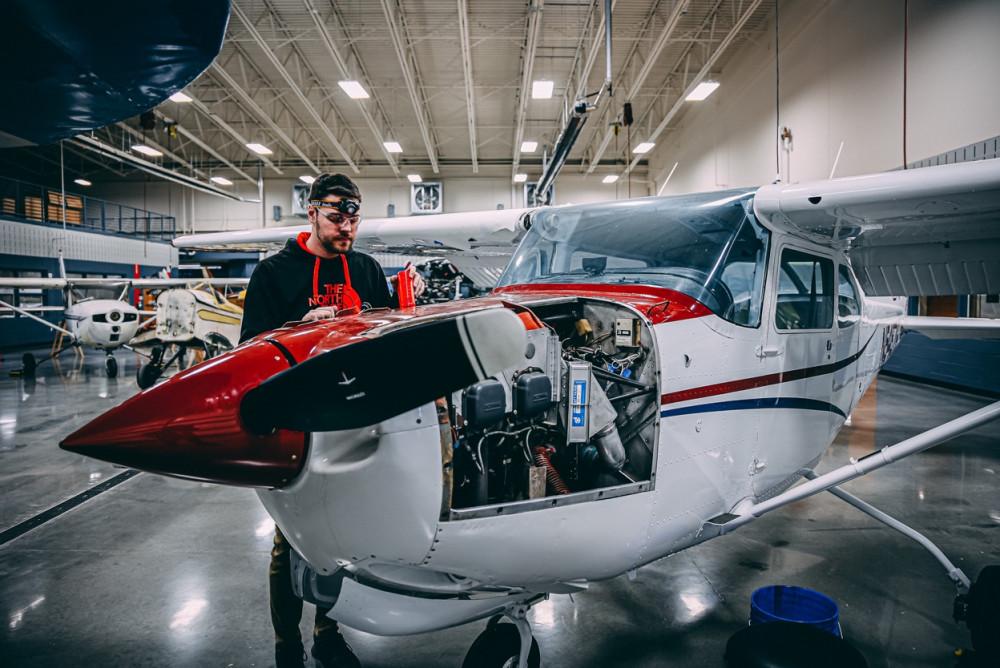Oklahoma is relatively unmatched in air superiority – on the ground at least.
Midwest City is home to the U.S. Department of Defense’s largest air depot at Tinker Air Force Base. Tulsa International Airport houses the largest commercial airline maintenance, repair and overhaul (MRO) facility on the planet.
Geography contributes as both cities are roughly equidistant (1,400 miles, one way) to both Los Angeles and New York.
Just a handful of accredited educational facilities exist statewide, which collectively supply aircraft maintenance technicians who keep aircraft airworthy. Canadian Valley Technology Center’s El Reno Campus is among them.
CV Tech’s Aviation Maintenance Technology program is certified by the Federal Aviation Administration (FAA) to provide Part 147 curriculum, which requires structured coursework and a mandated 1,980 hours of class time (about 20 months). Students who complete the program are eligible to take the written, oral and practical Airframe and Powerplant (A&P) license exams.
Michael Homic, one of two program instructors at CV Tech, said students develop a broad knowledge of aircraft systems through advanced installation, overhauling and testing procedures. Curriculum covers sheet metal, reciprocating engines, ignition, landing gear, flight safety and much more.
“We let students drink from a fire hose while trying to digest new vocabulary in a fast-paced environment where a new subject is covered every week for the first semester,” Homic said. “We also try to give them a look inside the industry at what a work day for a typical technician is like.”
More than 120,000 people are employed in aerospace and defense industries at 1,100 locations statewide, according to information supplied by the state Department of Commerce. This includes MRO facilities and research and development businesses.
Homic estimates about 40 percent of CV Tech graduates go to work at Tinker, while about half that number go to work at major airlines, such as Skywest, American or Alaskan. About that same percentage work in MRO’s for manufacturers, such as AAR, Valair, Kratos and Textron. Others go to work in smaller, independent shops and contractors.
Recent graduates earn roughly $20 per hour to start and between $25 and $35 per hour after a year on the job, said Rocke Tyler, also a CV Tech instructor. Students are aware of the opportunities available to them after completing the program.
“I am certain that I will get a job as soon as I get out of school,” said recent graduate Cade Recknagel. “I spoke with a couple different companies, and they were interested in hiring me as soon as I get my certification.”
Recknagel attended tuition-free using the Next Step Scholarship. It is available to all applicants who are under age 24 and who live in CV Tech’s district area. A diploma or equivalent is required. For others, the cost is $2 per hour. Books and fees still apply in either case. Only post-secondary students are admitted into the program. No knowledge of aviation is expected of new students.
The summer class schedule is from 8:30 a.m. to 3:30 p.m., Monday through Thursday. The August to May schedule is from 8:30 a.m. to 3:30 p.m., Monday through Friday. More information is available from Career Counselor Kristi Stephens at (405) 422-2252.
DID YOU KNOW?
Airports, air force bases and roads are named for famous aviators with state ties, including pilots Leon Vance, Wiley Post and astronauts Owen Garriott and Thomas Stafford. The technology center in Shawnee is named for astronaut Gordon Cooper. A famous female pilot, Bessie Coleman, spent a semester at Langston University. This qualifies her as an adopted Oklahoman. Coleman became a renowned biplane stunt flyer in the 1920s. She is also the first black woman and first Native American (as a quarter Cherokee) to earn an aviation pilot’s license and to earn an international aviation license. Nothing substantial in Oklahoma is named for her. Bessie Coleman Middle School is located in Cedar Hill, Texas.


